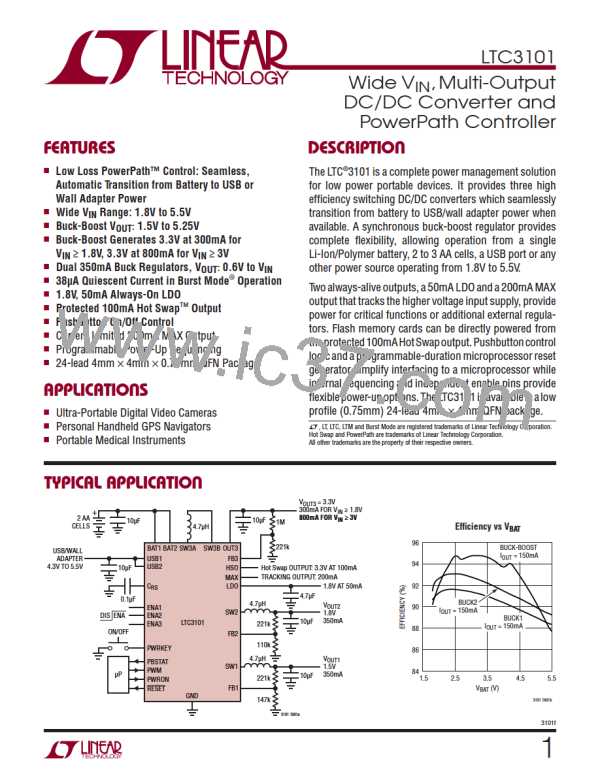LTC3101
OPERATION
Power Good Comparator Operation
may be cases at the boundary of reaching current limit
when the buck-boost converter is continuously in current
limit, causing the power good comparator to indicate a
fault, but the output voltage may be slightly above the
actual power good threshold.
The buck-boost converter contains an internal power
good comparator that continuously monitors the voltage
of the feedback pin FB3. The output of this comparator
is used during power-up for sequencing purposes. In ad-
dition, during operation, if the power good comparator
COMMON FUNCTIONS
Thermal Shutdown
indicates a fault condition, C and RESET will be driven
RS
low. This feature can be used to reset a microprocessor
in the application circuit if the buck-boost output loses
regulation.
Ifthedietemperatureexceeds150°CallDC/DCconverters
will be disabled. In addition, the LDO and MAX outputs are
disabled. All power devices are turned off and all switch
nodeswillbehighimpedance. Thesoft-startcircuitsforall
converters are reset during thermal shutdown to provide
a smooth recovery once the overtemperature condition is
eliminated. All DC/DC converters (if enabled) and the LDO
and MAX outputs will restart when the die temperature
drops to approximately 140°C.
In Burst Mode operation (PWM = low), the buck-boost
power good comparator will indicate a fault when the
feedbackvoltagefallsapproximately8.5%belowtheregu-
lation voltage. There is approximately 2.5% hysteresis in
this threshold when the output voltage is returning good.
In addition, there is a 60ꢀs typical deglitching delay in
order to prevent false trips due to short duration voltage
transients in response to load steps.
In PWM mode, operation of the power good comparator
is complicated by the fact that the feedback pin voltage
is driven to the reference voltage independent of the
output voltage through the action of the voltage mode
error amplifier. Since the soft-start is voltage mode, the
feedback voltage will track the output voltage correctly
during soft-start, and the power good comparator output
will correctly indicate the point at which the buck-boost
attains regulation at the end of soft-start. However, once
in regulation, the feedback voltage will no longer track the
output voltage and the power good comparator will not
immediately respond to a loss of regulation in the output.
For this reason, the power good comparator output is also
designed to indicate a fault condition if the buck-boost
converter enters current limit. The only means by which a
loss of regulation can occur is if the current limit has been
reachedtherebypreventingthebuck-boostconverterfrom
delivering the required output current. In such cases, the
occurrence of current limit will directly cause the power
good comparator to indicate a fault state. However, there
Undervoltage Lockout
If the supply voltage decreases below 1.65V (typical) then
allDC/DCconverterswillbedisabledandallpowerdevices
are turned off. In addition, the MAX and LDO outputs are
disabled. The LDO is forced into its reverse blocking state,
allowing the LDO output to remain powered with less
than 1μA reverse current being drawn by the LTC3101.
The soft-start circuits for all DC/DC converters are reset
during undervoltage lockout to provide a smooth restart
once the input voltage rises above the undervoltage
lockout threshold.
Active Output Discharge
All three DC/DC converter outputs are actively discharged
to ground when disabled through 1kΩ (typical) imped-
ances.Thebuckconverteroutputsaredischargedthrough
the inductor via a pull-down resistor on the respective
switch pin.
3101f
20

 Linear [ Linear ]
Linear [ Linear ]